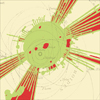Sun Ra, "The Heliocentric Worlds of Sun Ra"
 ESP Disk's most recent re-issue of the now well-known and loved Heliocentric Worlds series is haphazard and sloppy, offering only the most minimal improvements over their last re-issue from 2005. Fledgling Ra listeners will be happy to find all three volumes together in one package (this time on three distinct discs), but everyone else will likely be disappointed by the lackluster bonus material, mediocre packaging, and poorly edited liner notes. Anyone who owns all three albums already can safely ignore this release, the rest of us can bemoan its poor presentation.
ESP Disk's most recent re-issue of the now well-known and loved Heliocentric Worlds series is haphazard and sloppy, offering only the most minimal improvements over their last re-issue from 2005. Fledgling Ra listeners will be happy to find all three volumes together in one package (this time on three distinct discs), but everyone else will likely be disappointed by the lackluster bonus material, mediocre packaging, and poorly edited liner notes. Anyone who owns all three albums already can safely ignore this release, the rest of us can bemoan its poor presentation.
Each of the three Heliocentric volumes were performed and recorded in the span of less than a year, between April and November of 1965. Ra was accompanied by the same 12 musicians for both dates, among them multi-instrumentalist Marshall Allen (probably most famous for his sax playing), bassist Ronnie Boykins, and baritone sax player Pat Patrick (Massachusetts Governor Deval Patrick's father). Roughly 19 instruments find their way onto the record, including tuned tympani, bass clarinet and bass trombone, the clavioline, tuned bongos, bass marimba, and an electronic celesta. Band size, instrumental choices, excellent performances, unclassifiable sounds, and the improvisational structure of all three volumes have earned these records an important place in the history of free jazz, as well as a legendary status. They were performed and released before John Coltrane's Ascension, broke strongly with the turbulent and wilder styling of Ornette Coleman's double quartet, and showcased an altogether different sound for the Arkestra, which had just released a string of excellent, but more readily digestible records, including Cosmic Tones for Mental Therapy. Along with The Magic City, The Heliocentric Worlds of Sun Ra most strongly define Ra's New York period sound and represent some of his most enduring ideas as a composer and band leader. Whether or not they can be classified as free jazz is another question entirely.
Listening to Vol. 1 and Vol. 2, I focused immediately on their fragmented, frequently clumsy ensemble and solo passages. Boykins, percussionists Jimhmi Johnson, Pat Patrick, and Roger Blank, and the rest of the Arkestra spend much of their time stumbling over (and sometimes through) their instruments, producing atonal passages of a childish quality with seemingly little attention paid to structure, melody, or rhythm. Nothing I'd heard or read before could help me get inside the tympani and bass duets of "Heliocentric" or the drunken clavioline and piano fights on "Nebulae." The best I could muster was a feeble comparison to early Nurse with Wound records, because Ra's sudden tempo changes and unusual instrumentation produced effects and contrasting textures that reminded me of the tape collages Stapleton produced. After listening more closely and reading some helpful articles, I was clued into the structure hiding behind the chaos, and subsequently into the beauty and originality of the Arkestra's sound.
Ra would conduct his large group by pairing instruments together and providing them loose rules. For instance, Boykins would be instructed to bow his bass, or trombonist Teddy Nance would be told to play long, whole notes against a contrasting rapidly moving flute solo, and both would be paired with seemingly unrelated percussion solos, wood blocks, or bass marimba. Each group of musicians would solo together, but only as Ra conducted them to do so and only according to a mood or idea Ra was exploring. So in one instant trombone and sax are playing together, and then the wood block and bass, and at any moment the whole band could erupt in a fit of excitement and noise, each with a wave of Ra's hand. The results are bizarre or surreal duets, trios, or ensemble movements with instruments that either contrast each other strongly or blend in awkward and glaring ways. My favorite example is when Ra pairs Robert Cummings' woodblocks and his own bass marimba with Boykins' already prominent acoustic bass. These two or three instruments fuse almost completely and very nearly produce the illusion of a single instrument, but their distinct timbres and colors keep them from having an entirely happy marriage.
I originally thought Sun Ra was seeking to create or highlight diversity and disparity in his music. The failure of his instruments to blend completely emphasized that, but so did the clumsy melodic phrases and tottering rhythms. Time, greater familiarity with Ra's music, and a little studying have changed my mind, and I now think the opposite is true. Boykins' bass playing on "The Sun Myth" is like nothing I've heard in jazz; it resembles the bowing of a bass in a classical orchestra more strongly than anything in jazz. And the loud percussion passages sound like a child's first drum lesson, but the Arkestra manages to force these two unlikely partners into a striking, if coarse, unity. Elsewhere, Ra pits shrieking saxophones against a background of swirling cymbals and buzzing electronic tones. Convention suggests these elements can't or shouldn't be paired, but the Arkestra miraculously draws them together. Their success depends both on Ra's guidance and on each musician's finely honed abilities; such abstract and spontaneous playing is neither easy nor natural. The resulting moods are sometimes tense, other times meditative, and frequently humorous or playful. Only rarely can the Arkestra be said to play as a band in any traditional sense. Parts of the third volume, as well as "Cosmic Chaos" and "Of Heavenly Things," feature a tighter logic and more coherent sense of counterpoint, so those songs make a more immediate kind of sense. But, for much of the record, we listeners are required to explore the depths of their expectations and interpretive skills in order to encounter the Arkestra's power and philosophy fully.
That's one of several reasons these records have taken such a hold on me. Their fluid character is another. Written and performed in the middle of New York City during the 1960s, Ra was automatically placed among the free jazz moguls of the time, but very few of these songs sound like jazz compositions at all, free or otherwise. I do hear fragments of jazz's past, but classical music, noise, tape collage, and other early electronic phrasings and expressions are present, too . I can't offer a better categorization, but I tend to agree with the theory that these records were filed under free jazz because nobody knew what else to call them.
Unfortunately, ESP Disk has done little to support the wonder and depth of Ra's music. This three disc set promises a lot and pretends to make good on them with an attractive outer sleeve and smartly distributed index of songs. Each of the three volumes gets its own disc, meaning none of them are muddled by bonus songs and none of them flow into each other unnaturally. When a disc ends, the album ends, too, and I applaud ESP's decision to keep each record distinct in that way. The original artwork for each album is also represented, although they're all tucked away beneath transparent CD trays. Still, unfolding the box set reveals a neat and simple layout. It's not the most attractive presentation in the world, but it functions well and I'm not sure how I would change it to make it any better. However, there's no booklet included with this set, and that's the first big problem I have with it. Extensive liner notes are nowhere to be found and only the most meager information about these records is provided on the back panel. Considering Sun Ra's ever-increasing popularity and the scope of the Arkestra's history, I'm surprised there wasn't more information provided up front. Things continue to deteriorate as I scan what little information is provided. Sun Ra's electronic keyboard, the "clavioline," is misspelled "clavoline" and the song "Of Heavenly Things" is misprinted as "Oh Heavenly Things." Additionally, "piccolo" is spelled as "picolo" on the back cover. These are small complaints, but they make the package feel cheaper and more hastily assembled than it should.
An impressive lineup of bonus features could make up for these mistakes, but calling any of the extras a bonus would be stretching it a bit.The first disc contains a roughly 16-minute "documentary" titled Spaceways. It's less a documentary film and more a piece of propaganda for Sun Ra's philosophy and ideas. If any of the bonuses are going to appeal to a Sun Ra fan, this is the one, but much of what Ra has to say can be found in books about him or in articles easily found on the Internet. Furthermore, the quality of the audio and video is low, probably because it was pulled from the original film without any effort given to improving its sometimes murky dialog and overall grainy picture. The second disc contains a "Sun Ra Photo Archive" that is little more than 12 JPEG files. A few of those files are images of the album covers, which are widely available everywhere and featured prominently in the set's artwork already. The other images may have their own value, but hardly constitute an archive. The critical writings "archive" on the third disc is a collection of Acrobat files containing reviews from publications large and small, including a Rolling Stone interview, a couple of brief mentions in The New York Times, and liner notes for all three volumes. Two of the reviews are very well written, reproduced clearly, and provide helpful information about the Heliocentric recordings. The remainder are poor scans of newspaper articles. The Rolling Stone feature could be a good read, but features tiny text and fuzzy image quality, which makes reading it tedious. Worse yet, the liner notes for each record, which should have been printed in a separate booklet (or at least somewhere in the box set itself), are included as part of this "archive." This isn't just cheap, it's insulting. ESP are basically lying to their audience about the content of their bonus material by including basic and necessary information for any good box set as a "bonus" feature. That's a lot like giving a giant middle finger to the consumer.
Having some of Sun Ra's best music made more readily available is truly exciting and a blessing. So much of his music is rarer than it should be. But the artwork, details, and presentation of that music should be treated with as much reverence and care as the music itself is.
samples:
 




